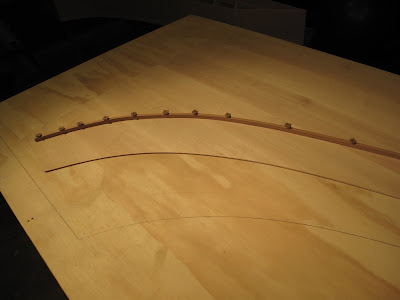This weather was a little cooler this weekend and the relative humidity stayed around 50% for most of the time so it was a good opportunity to get some more work done on the soundboard.
The soundboard is 1/8" thick and has to be thinned down to about 3/32" in several places around the edges. This is really quite easy to do with a good sharp plane and the soundboard securely clamped down to the workbench. I started out very slowly and carefully getting the edges down to just the right thickness and then working gradually inwards. Things went a bit faster once I got some confidence in what I was doing and pretty soon it was all done.
Attaching the bridge was something that I was quite worried about. Gluing on the nut had turned out to be much more difficult than I had expected and I had a couple of near disasters while doing it although I was able to recover from all of them. The biggest problems were with the nails used to position and hold down the nut during gluing. The nut, which has exactly the same profile as the bridge has a "step" in it at the top - the nail goes through a hole in the lower part of this "step" and you have rely on the cardboard pads on the nail to distribute the pressure evenly. This turned out to be easier said than done and I dented the wood just a little in a couple of places, but fortunately was able to apply a damp cloth to those areas and get the wood to swell back into place. The second problem was getting the nails back out again! The wrestplank into which the nails have been hammered is made of oak - it is bad enough trying to get the nails to go into it and even more difficult to get them to come back out again. Of the 9 or 10 nails used to hold down the nut only 4 came out cleanly - the heads broke off all of the others. Of those I managed to get all but 2 out using a vice grip, but the last 2 just wouldn't move so I had to clip them off as close to the hole as possible and then trying hammering them just a little further in using a nail set.
So, when it came to the bridge (which was going to need 19 nails) I changed a few things.
The first thing that I did was to go looking for some stronger nails - I found some #17 nails which were quite a bit thicker than the ones that had been supplied but still fit easily through the 1/16" holes in the bridge. I also decided to use something better than just cardboard pads to cushion the nails and I found some small cork pads with a self adhesive backing that looked suitable. I put two of them together back to back and then attached half of a third pad to create a step that approximately matched the profile of the top of the bridge. I then added a cardboard pad on top to stop the nail from just embedding itself in the cork.
I then did a few experiments to make sure that I could hammer these nails into the plywood top of the workbench and still get them out again and reassured myself that it seemed to be possible.
So with lots of masking tape to catch as much of the glue as possible I went ahead and glued down the bridge. A lot has to be done very quickly to get the bridge positioned and nailed down so I didn't have time to take any pictures of that process, but here are a few shots of how it looked once the masking tape was removed.


Here you can see how the stack of cork pads compresses and deforms nicely to match the profile of the bridge.

... and this time all of the nails came out in one piece ...
There is still more work to be done to attach some wooden ribs to the underside of the soundboard before it can be glued into the case, but here are some shots of it sitting in place with the bridge glued down.

